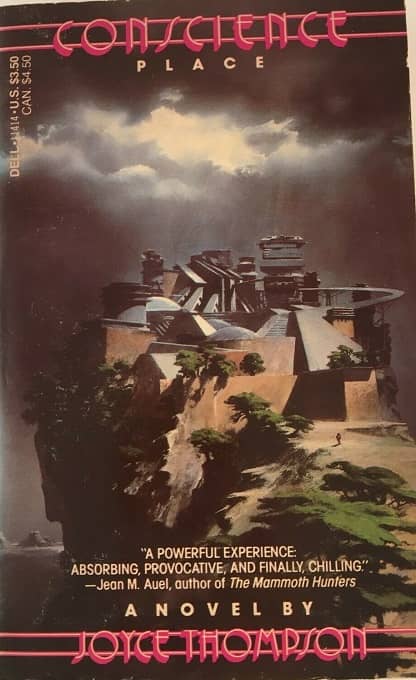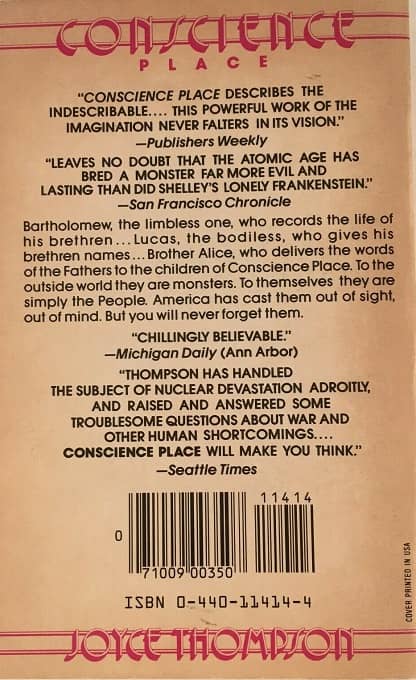Conscience Place and Story Mind
 |
 |
Conscience Place by Joyce Thompson (Dell, 1986, cover by John Harris)
In a conversation with my son this week, the term “neurological diversity” arose. It entered the room courtesy of Greta Thornburg in conversation with Naomi Klein. Greta described her prodigious ability to research, absorb and synthesize complex information as a sort of compensation for lacking the more common gift of social intelligence. My son, who’s teaching an undergrad lit class in Berkeley’s African American Studies department about invoking and communing with ancestors surmised that the ability to see and communicate with the dead might be a real if not common human gift — another way of being differently able.
Click.
I recently read my 1984 novel Conscience Place for the first time in 35 years. It was about to be republished. My task was to proof the scanned text, and I secretly gave myself permission to make small tweaks if I thought they were needed. Thirty five years is a long time, after all, and I feared being embarrassed by a writer I no longer am telling a story in ways I no longer would to an audience of readers who might no longer give a s—t.
Click.
While I no longer remembered the text, I have never forgotten the experience of writing Conscience Place, never forgotten being thrown headfirst into a strange new world. I was supposed to bring all my skills as a writer with me, but none of my assumptions or prejudices. Until then, all of my work — 3 novels and a book of stories — had begun with a voice speaking inside my head.
Click.
Here’s what I wrote in the introduction to the new edition:
Conscience Place arrived as an image. It wasn’t a picture of anything recognizable, but a luminous silvery shape suspended against deep black. I was working hard on something else at the time but the silver image sucked all the air out of that story and left it dead by the side of the road.
I more or less got it that the image was a feeling tone, that last consummating chord played on the keyboard of nerves and hormones, skin and memory that is the human instrument. It’s how a story makes you feel, if only for a moment. The image of the silver shape on black was how the incoming story was supposed to make people feel. And I was supposed to translate that image into words so they could.
When I opened my notebook and took up my pen, the story was ready. It started with a set of premises, pitched in the other-worldly voice of an origin story. I decided I’d take down the ideas and get rid of the voice later. In the end, it persisted. What the voice set up was a sort of mythic long shot. When I zoomed in I was at The Place, among The People.
Click.
Last May, I was afraid my former self would shame me. Instead, I got sucked into the story once again. I remembered writing every word, in a kind of heightened state that was both composition and transcription. I remembered the sense of not making things up but letting them show up and pass through me. I remembered choosing words and writing scenes as if they were poems, with as much attention to rhythm and image and the silence of white spaces as to event. I found that the voice of the prose still lived in my central nervous system and it still had the power to carry me into a place of elastic compassion and surpassing strangeness. Now and then, I recognized a fleeting image or a moment or an attribute that reflected my then-real-life, but mostly, the Place felt like a whole-cloth creation. In today’s living room, I wept. A thirty-five year old story still had the power to break my heart.
Click.
When my son and I talked about neurological diversity this week, I realized I’d been noodling on the knowledge that the best of my six published and even-more-written novels are stories that passed through me, not ones that arose as ideas in my brain. They arrived with the sense that the story itself already existed in some alternate space and it was my job to bring it into this one. I’ve surmised in the past that this is simply a means of banishing self-consciousness, getting out of my own way, but I don’t really believe that’s true. Almost all of my short stories — and I’m quite good at the form — arise directly from my real life. Writing them is trying to make truth out of past. My stories happen through deep memory and conscious craft. My best novels — and these are all genre novels — happen through a sort of extended trance possession.
Click.
One last data point. I’ve taught lots of writing workshops over the years — a couple weeks at Clarion among them — and it’s sometimes though not always my experience that a student’s work-in-progress has an intention that’s at odds with what the writer is trying to make it mean or do. In most cases, I respect my role as medium and deliver the message to the writer. Once the vision is clear, I can help with craft.
I am willing to believe that there’s a channel through which story flows into the world. I am willing to believe there can exist a neural channel that lets us hold that water in our hands. I am profoundly grateful to have experienced this story mind a time or two.
Joyce Thompson’s The Blue Chair was published by then-Avon editor, Susan Moldow, in 1977. Five more novels, two collections of short stories and a memoir followed. As the single mother of two and needing money, she novelized the film Harry and Hendersons, which became a popular kids’ book club selection. When fifth grade teachers gave their annual Write your Favorite Author assignment, bags of mail turned up on Thompson’s front porch. Unable to answer, she hid it all in the crawlspace under the stairs where it remained until her daughter found and read it. 30 years later, she sincerely apologizes for not thanking the young fan who named his pet bunny after her.
Since 1995, Thompson has supported her writing habit as an interviewer and technology product marketer for a number of prominent hardware and software companies. She lives in Oakland, CA where the barrio meets the hood with her husband Schuyler ingle, and a moody geriatric cat.
A new edition of Conscience Place was recently published by the eco-warriors of Jericho Hill Publishing–the 12th, if you count all the formats and translations from the 80s. It’s on Amazon in trade paperback and Kindle editions. Pairs well with Chernobyl, the HBO series.
Thanks, John O’Neill, for the invitation to contribute here.
You’re most welcome, Joyce!
I’ve often heard fiction authors explain their experience of writing as if things just showed up, as if the writer didn’t really create the things on the page but was simply a siphon through which the “creations” came.
Is there some sort of deep neurological activity that is simply experienced as mystical process? Or is there something really transcendent going on?
Most likely the former. Feels like the latter.
Recombinant image and sensation. Escape from logic feels like magic but is probably just logic redefined.
I’m more sympathetic to it being the latter but that opens up a whole host of other questions. I think it’s definitely simpler (in Occam’s Razor fashion) to believe it’s the former.
Thanks for the post!
When it happens, it feels like a gift. The important thing is to accept and show up.
Why do you prefer the latter?
Why do you prefer the latter?
I believe in the supernatural.
Based on evidence or desire?
Evidence.
How about you? Evidence or desire?
A desire for intellectual correctness.
Or preferring not to reveal too much.
I was recently contacted by a young filmmaker whose mom has read Conscience Place once a year since it was first published in her native Hungarian. We ended up collaborating on a screenplay, now completed–in the middle of a writers’ strike. But I think we nailed it. Just saying.